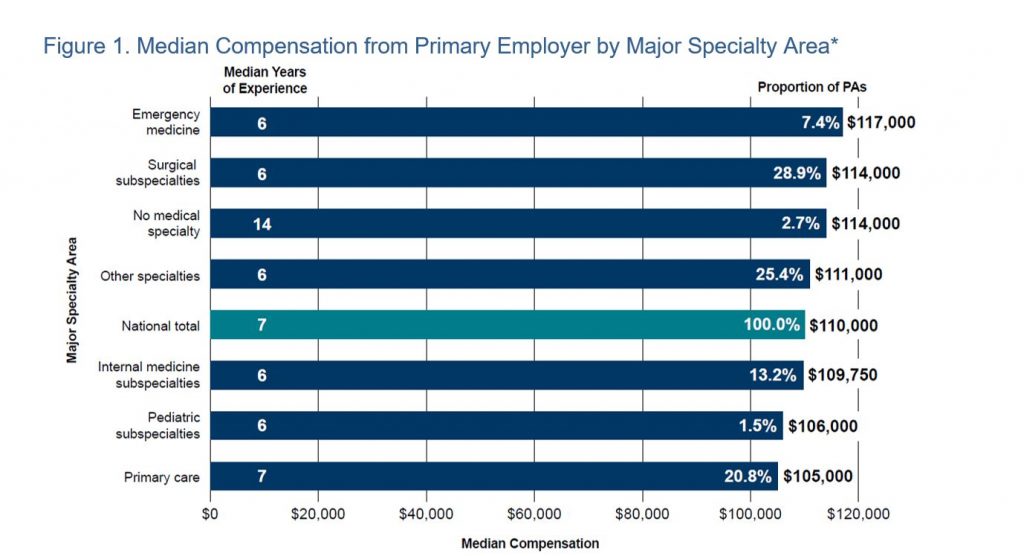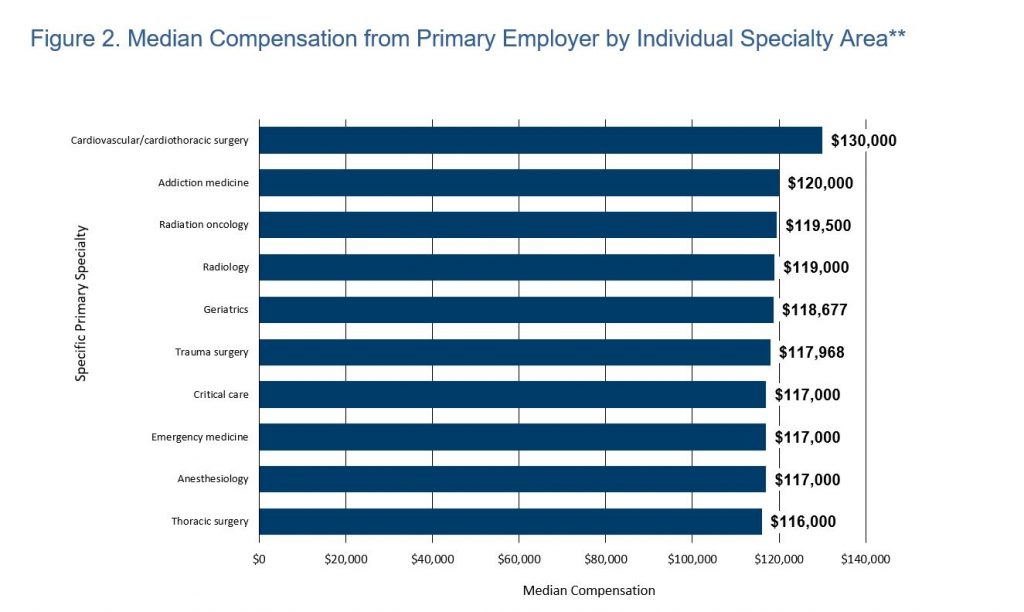Top 10 Paying Specialties in the PA Profession in 2020
Cardiovascular/Cardiothoracic Surgery Specialty Tops 2020 Compensation
June 16, 2021
By AAPA Research Department
The PA profession includes PAs who work in several dozen specialties, ranging from family or emergency medicine to pathology or hospital medicine. Compensation differs substantially between some specialties. The AAPA Salary Report reports compensation by specialty in two ways. First, we group more than 54 specialties into seven distinct categories, which we call “major specialty areas.” (See below for the detailed list of specific specialties grouped by “major specialty area.”) Compensation statistics based on “major specialty area” are included in the first section of the categories.

Based on this data from thousands of PAs, one may conclude that emergency medicine is the highest paid specialty. However, it is important to remember that these categories include compensation for each specific specialty within the category, and several of the categories include many specialties. This data show that the emergency medicine “major specialty area” is the highest paid. But what are the top paid specific specialties in the PA profession currently?

Individual specialty area
In addition to reporting compensation of major specialty areas, the AAPA Salary Report also reports median compensation by individual specialty area. When examining compensation between specific specialties, rather than major specialty areas, emergency medicine still has a high level of compensation in the profession. Emergency medicine as a specific specialty among the 54 examined specialties comes in as the eighth-highest paying specific specialty area. The top spots go to surgical and “other” subspecialties: cardiovascular/cardiothoracic surgery, addiction medicine, radiation oncology, radiology, and geriatrics. All 10 specialties in the top 10 list are compensated above the national median of $111,000. It is important to note that as mentioned in the 2021 AAPA Salary Report, 2020 saw a dip in compensation, due in part to changes related to COVID-19 and dips in hourly compensation. As a result, the top 10 paid specialties changed from last year’s numbers.

Other factors associated with compensation
While specific specialty is in fact associated with compensation, it is not the only factor associated with it. First, among all PAs, median years of experience as a PA is seven years, and PAs in four of the top 10 highest paid specialties have more years of experience than the national average. We also know from previous research that examined the role of gender in total compensation that a variety of other factors are also associated with compensation. For example, an AAPA Research study, published in JAAPA in 2020 and based on 2019 compensation data, indicated that geographic region of work, statewide cost of living, mode of compensation, whether a bonus was received, years of experience, primary specialty, primary work setting, hours worked weekly, weeks worked annually, patients seen weekly, whether or not a PA took call, leadership roles, and ownership in a practice also predict compensation in PAs.
Changes due to COVID-19
Some of these substantial changes in compensation between 2019 and 2020 may also be due in part to COVID-19. PAs were asked as part of the 2021 AAPA Salary Survey whether any of the following changed (either an increase or a decrease) at their primary employer because of the COVID-19 pandemic: hours worked, bonus, annual merit/pay increases, base pay, professional development funds, paid time off, and/or retirement benefits. Among all respondents to the survey, 64.1% were impacted in one or more ways with a change to their hours worked (42.7% of respondents), bonus (24.5% of respondents), annual merit/pay increase (17.3% of respondents), base pay (16.0% of respondents), professional development funds (14.7% of respondents), paid time off (11.0% of respondents), and retirement benefits (9.1% of respondents). Of those respondents who reported impacts to their hours worked weekly of base pay due specifically to COVID-19, roughly one-third saw increases, one-third saw no change, and one-third saw decreases to their hours worked or their base pay year-over-year.

Specific specialties and major specialty areas
About the data
The data reflect PAs who worked 32 hours or more per week in 2020. “Compensation” includes all compensation types: base salary, annualized hourly wage, and productivity pay. Compensation statistics in this article do not include bonus (if one was received).
*For the median compensation by major specialty area graph near the beginning of this article, percentages inside bars of graph indicate the percentage of PAs who report that employer specialty as their primary specialty area. The percentages and median years of experience may slightly differ from the profession-wide percentage as they reflect full-time PAs who provided their compensation in the 2021 AAPA Salary Survey.
**Only specialties with 20 or more respondents nationwide are included.
Author is Timothy C. McCall, PhD, associate director of surveys & analysis at AAPA. Contact him at [email protected].
You May Also Like
2021 AAPA Salary Report
Thank you for reading AAPA’s News Central
You have 2 articles left this month. Create a free account to read more stories, or become a member for more access to exclusive benefits! Already have an account? Log in.



